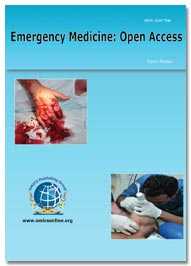Theme: Supporting the Spirit of Life
Palliative Care-2015
Hospice Care is an approach which improves the quality of life of a terminally ill, chronically or seriously ill person.This is achieved by attending to their emotional needs. The goal of the care is to help people who are dying have peace, comfort, and dignity.The caregivers try to control pain and other symptoms so a person can remain as alert and comfortable as possible thus providing some sort of relief to the persons’ family too.
Palliative Care focuses on weakening the pain, symptoms, physical and mental stress that a seriously ill patient goes through while being treated.Like Hospice Care it is also designed to provide some sort of physical and mental relief to the patient and their families too.
OMICS Group Conferences feel proud to organize "International Conference on Hospice and Palliative Care" (Palliative Care-2015) with a theme of “Supporting the Spirit of Life” which is to be held during August 31 - September 02, 2015 at Orlando, Florida, USA.
We welcome and invite you to participate in our Premier event.
"Palliative Care-2015" aims to gathering participants from all Leading Universities, Clinical Research Institutions, Doctors, Nursing Professionals, Specialists in Health Care and Diagnostic Companies to share their experience and research aspects in the rapidly expanding field and thereby, providing a showcase of the latest techniques in Emergency Medicine.We aim at understanding the complexities faced by the relevant people of the industry and evolving towards a better direction in the field of Hospice and Palliative Care
OMICS International Organises 300+ Conferences Every Year across USA, Europe & Asia with support from 1000 more scientific societies and Publishes 400+ Open access journals which contains over 30000 eminent personalities, reputed scientists as editorial board members.
Track 1. Hospice Care
The number of Hospice Care agencies in USA alone has taken a magnification over the last decade and currently there are more than 3700 Hospice Care Agencies in USA alone accommodating approximately 2 Million patients per year.
Hospice care is end-of-life care. A team of health care professionals and volunteers provides it. They give medical, psychological, and spiritual support. The goal of the care is to avail people who are dying have placidity, comfort, and dignity. It deals with the Pain and symptom control of a person who is either terminally ill or is undergoing severe treatments like Chemotherapy etc. Caring with physical, emotional and spiritual support services and its advancement in a way that the dying people can live the rest of their life in peace and comfort. Resource utilization and its outcome is mainly focused on using a clinical nurse or a physician for aiding communication between the patients and patients’ families for reduced length of stay at a caring organization in order to utilize the resources quite wisely and the outcomes should come in handy. Keys to success lies in the protocols to be followed while having a patient in a hospice care facility.
To understand, feel and control the pain of a terminally ill patient is the motive of Hospice Care.
Track 2. Palliative Care
The number of hospital palliative care teams in the United States has grown dramatically over the past decade. The prevalence of palliative care in U.S. hospitals with 50 beds or more has nearly tripled since 2000, reaching 61 percent of all hospitals of this size. As of 2012, 1734 out 2844 hospitals with 50 beds or more reported a team and these teams are serving an estimated 6 Million Americans.
Palliative Care fixates on debilitating the pain, symptoms, physical and noetic stress that an earnestly ill patient goes through while being treated. Like Hospice Care it is also designed to provide some sort of physical and mental relief to the patient and their families too. Palliative Nursing is a very vital part of the topic as the care and compassion provided to the patient is mostly done by a clinical nurse or a physician. “Palliative care is not just for someone likely to die after trauma but for anyone who is seriously injured who is frail or has other life-limiting illness.
Elderly trauma patients have many desiderata beyond their injuries. Research shows that compared with younger people who have sustained trauma, individuals older than 55 years are more liable to experience multiple organ failure after trauma,1 and even mildly injured patients above age 60 have a five times more preponderant risk of dying. People nearing the terminus of their lives who receive palliative care have better salubrity and quality of life as well as amended assuagement of pain and other symptoms compared with those who do not receive this auxiliary care in emergency situations. Nursing is the protection, promotion, and optimization of health and abilities, prevention of illness and injury, through the diagnosis and treatment. The palliative nursing facilitates state-of-the-art processes, organizational transitions, analytics, and technology innovation within the health industry and academia, regarding transformational care distribution and health management models.
Track 3. Palliative Care for Special Situations
Chronic diseases constitute a major cause of mortality and the World Health Organization (WHO) reports chronic non-communicable conditions to be by far the leading cause of mortality in the world, representing 35 million deaths in 2005 and over 60% of all deaths
Hospice care is broadly categorized for different situations as a result of different diseases. Specially designed caring facilities are established for patients who have Cancer, AIDS, ALS, Emphysema, Heart Failure, Kidney Disease/Renal Failure and other terminal illness.
Track 4. Palliative Care Services
The number of hospital palliative care teams in the United States has grown dramatically over the past decade. The prevalence of palliative care in U.S. hospitals with 50 beds or more has nearly tripled since 2000, reaching 61 percent of all hospitals of this size. As of 2012, 1734 out 2844 hospitals with 50 beds or more reported a team and these teams are serving an estimated 6 Million Americans.
Palliative Care aim to treat, as early as possible, the symptoms of the disease and any psychological, social and spiritual problems related to the illness. It also assist families and caregivers through this experience and provide a bereavement support service to people who are grieving.
It aims at Assessment and Treatment of Symptoms along with Psychosocial Support and Co-ordination of Care by the cross-linking network of Doctors of different expertise and their remarks.
Track 5. Care giving Models
Out of all the hospice based programs nearly 89% of all the agencies across the US are now providing Volunteer and Bereavement Services.
The most important part of providing care is to have a clear understanding of what support or type of support does a patient in unbearable pain needs. In order to make the understanding very clear doctors and other clinical practitioners come up with different Care Giving Models gradually.
Mostly the models include programs which are either Hospital Based or Hospice Based.
Different staffing programs force the inclusion of very well trained and experienced staffs.
Each patient-family unit is unique, and hospice care accommodates your specific needs. If care can be provided safely in your home and that us where you want to be, your team will do everything it can to make this possible. Customary nursing visits, on-call availability, convivial work support, avail from certified nursing auxiliaries and practical avail from volunteers can consummate this wish for most families. If age, infirmity or other circumstances make hospice home care too difficult, you may have the option of staying in a hospice facility designed to be home-like and welcoming to your family. Hospice care can also be provided in assisted living or nursing facilities.
For all these facilities to be provided we need well trained guys and that we can achieve by proper care giving training and certification after completion of the program.
Different volunteering and bereavement services also plays a very important role while it comes to hospice and palliative care by providing every sort of support a patient or his/her family requires at a particular time.
The number of Volunteer Services and Bereavement Services has been increased later in this decade.
Track 6. Research in Care and Medicine
Currently in USA Palliative Medicine market generates 18 Billion USD annually with an annual growth of 1.1 % and providing employment to about 2 Million People.
Conventional nursing visits, on-call availability, convivial work support, avail from certified nursing auxiliaries and practical avail from volunteers can consummate this wish for most families. There are sundry ethical issues that pose particular challenges in the area of palliative care research. There have withal been many palliative care studies which have been locally predicated or diminutive in scale, and therefore arduous to generalize. Multi-disciplinary and multi-Centered collaboration is particularly subsidiary in providing utilizable palliative care research. It is essential that palliative care in USA perpetuates to build on the current research base, engendering high quality research to sanction practitioners to provide evidence-predicated care. It is through this cycle of research, implementation and evaluation that practice is ameliorated and patient care enhanced. The main content includes Symptoms Management, Strategies on Education and Therapies, Health Service Research, Trials and RCT (Randomized Controlled Trials), Developing Palliative Medicines, Palliative Sedation.
Track 7. Neonatal and Pediatric Care
There are 75 million children in USA accounting for 24% of total US population (315 million) in 2013. They are primarily covered by either Employee Sponsored Health Insurance programs (41.4 million in 2010) or by federal-state sponsored Medicaid insurance programs (26.8 million in 2010) and approximately 7 million children were uninsured. ESI covered 41.4 million children in 2010. Since 2007, the population of children covered by ESI declined 5.7%. Insurers and beneficiaries spent $87.9 billion on health care for children in 2010. Since 2007, total health care expenditures on children grew 11.9 %. Americans spent over 31.1% of their health care dollars for children on teenagers and 31.4% on infants and toddlers.
Pediatric and Neonatal Palliative care is specialized medical care for children and infants with serious illnesses. It fixates on providing palliation from the symptoms, pain, and stresses of an earnest illness—whatever the diagnosis. The goal is to ameliorate quality of life for both the child and the family. Pediatric palliative care is provided by a team of medicos, nurses and other specialists who collaborate with a child’s other medicos as an extra layer of fortification. It is congruous at any age and at any stage of an illness and can be provided along with treatment betokened to remedy. Pediatric palliative care addresses an earnest medical condition, including genetic disorders, cancer, prematurity, neurologic disorders, heart and lung conditions and others. It mitigates the symptoms of these diseases, such as pain, shortness of breath, fatigue, constipation, nausea, loss of appetite and arduousness slumbering. This benefits both the child and the family by palliating the symptoms, pain and emotional wear-and-tear that can make facing an earnest illness so arduous for your child and your family caregivers homogeneous.
It withal covers Prenatal Care by frequent assessment and evaluation of Patient and Family and Expertise in the field of handling a child. Adept nursing is a very consequential part of Pediatric Palliative Care as the symptoms are so rigorous for some of the kids that it becomes unbearable for a child to bear the pain. At that point an adept nurse capitalizes the situation and takes cares of the adolescent patient.
Track 8. Pain Management
Developed markets will account for 57% of total spending; down from 73% is 2006. Statistic shows the market value of over the counter pain relief products in the United States in 2013, by outlet type. In that year, internal analgesic liquid pain relief products that were sold at multi outlets in the United States had a market value of 390.3Million USD. From 2006-2010 the global spending on medicine were found to be 658 (in billion dollars), 2011 the global spending’s on market has been increased to 956 (in Billion dollars), whereas in future 2016 it is expected to be 1,205(in Billion dollars) Pharmerging markets surpassed EU5 in total spending in 2010 and will reach 30% of global spending in 2016, as millions more people gain access to basic medicines.
Pain can forfend us by coercing us to repose an injury or to stop doing something, the experience of being in a state of uncontrolled pain is horrible, frightening, and can have a profound effect on our quality of life. Uncontrolled pain can: delay healing, decrease appetite, increase stress and disrupt sleep, cause anxiety and depression. The future level of ecumenical spending on medicines underscores the kindred challenges of access and affordability which face those who consume and pay for healthcare around the world. Alternatively, the expeditious growing of pharm merging markets will be driven predominantly by economic gains and elevating income, particularly for the lowest earners, coupled with regime commitments to fortify expanded access to rudimental healthcare accommodations, which will make medicines more broadly available and affordable to millions of people. It covers the main topics of Anesthesiology, Physiotherapy, and Pharmacological treatment along with the non-pharmacological approaches of Pain Management.
Track 9. Care of Young People
In 2013 the population of children in USA was about 24% of the total population (315 Million) Employee Sponsored Health Insurance programs (41.4 million in 2010) and federal-state sponsored Medicaid insurance programs (26.8 million in 2010) are the prime insurance providers for children and 7 Million odd children were left uninsured. ESI covered 41.4 million children in 2010. Since 2007, the population of children covered by ESI declined 5.7%. 87.9Billion USD was spent on Healthcare and Benefits of children by the Insurers and the beneficiaries. Since 2007, total health care expenditures on children grew 11.9 %. Americans spent over 31.1% of their health care dollars for children on teenagers and 31.4% on infants and toddler.
The goal is to amend quality of life of an adolescent person not disposed to sacrifice his life for the sake of a disease but in unbearable pain and illness. Palliative care is provided by a team of medicos, nurses and other specialists who collaborate with an Adolescent patients’ other medicos as an extra layer of fortification. It is opportune at any age and at any stage of an illness and can be provided along with treatment denoted to remedy. Palliative care addresses a serious medical condition, including genetic disorders, cancer, prematurity, neurologic disorders, heart and lung conditions and others. It relieves the symptoms of these diseases, such as pain, shortness of breath, fatigue, constipation, nausea, loss of appetite and difficulty sleeping. It starts with tracking different spectrums of illness, Multidisciplinary Holistic Care, Use of Communication Aids, Importance of Confidentiality, Access Associations, Local Support Groups, Statutory Agencies and Organizations and Counseling Techniques.
Track 10. Emergency Medicine and Healthcare
As of 1st May, 2015 total number of registered hospitals providing Emergency Medical Services in the world is 17779 as per World Health Organization (WHO).Out of which 2890 are based in the United States.
Emergency medicine is a medical specialty involving care for adult and pediatric patients with acute illnesses or injuries that require immediate medical attention. While not conventionally providing long-term or perpetuating care, emergency medicos diagnose a variety of illnesses and undertake acute interventions to resuscitate and stabilize patients.Medicos specializing in emergency medicine in the USA and Canada can enter fellowships to receive credentials in subspecialties. These are palliative care, critical-care medicine, medical toxicology, wilderness medicine, pediatric emergency medicine, sports medicine, disaster medicine, tactical medicine, ultrasound, pain medicine, emergency medical services, and undersea and hyperbaric medicine.
It cover wide range of topics such as Infectious Disease, Drug Overdose Management, Labor Assistance for Women, Cardiac Life Support, Trauma Resuscitation, Allergy and Immunology, Cardiovascular Care, Dermatology, Ear, Nose and Throat and Hematology and Oncology.
Track 11. Family Medicine and Rehabilitation
The Physical Rehabilitation Centers industry has fared relatively well in the five years to 2015. The industry has continued to grow, but growth slowed considerably following the recession, mainly because to consumers scaled back discretionary expenditure and federal funding of Medicare and Medicaid programs slowed. In the five years to 2015, it is estimated that industry revenue grew at an average annual rate of 1.2% to $29.1 billion, including a 0.9% increase in 2015 alone. Margins are also estimated to grow over the period, reaching 10.2% of industry revenue in 2015, up slightly from 9.8% in 2010.
Family Medicine is a focused on comprehensive health care for people of all ages; the specialist is denominated a family medico, family medico, or formerly family practitioner. It is a division of primary care that provides perpetuating and comprehensive health care for the individual and family across all ages, genders, diseases, and components of the body. It is predicated on cognizance of the patient in the context of the family and the community, accentuating disease aversion and health promotion. Rehabilitation is additionally kenned as physiatry, a branch of medicine that aims to enhance and renovate functional ability and quality of life to those with physical impairments or disabilities.This track particularly focuses on Infectious Disease, Drug Overdose Management, Labor assistance for Women, Cardiac Life Support, Trauma Resuscitation, Allergy and Immunology, Cardiovascular Care, Dermatology, Ear, Nose and Throat and Hematology and Oncology.
Track 12. Major Symptoms after Palliative Care
People often assume that those diagnosed with a life-threatening illness will automatically experience depression. True, people facing a serious illness are more likely than healthy people to suffer depression or anxiety. One study of terminally ill cancer patients, for example, found that at least 17% were clinically depressed. But that's less than one in five patients. Not all people in need of palliative care will experience depression.Delirium and Fatigue are very common neuropsychiatric disorder seen in the very ill and at the end of life and is distressing to patients, families, and caregivers. Although common, delirium is frequently misdiagnosed and poorly managed.
Track 13. Spirituality in Hospice and Palliative Care
Globally there are near about 5,000 end-of-life spiritual care providers out of which nearly 1700 are based in the United States.The population using these specially designed facilities was 0.8% in the last decade in the USA and the number has been increased to nearly 11.5%.
Spirituality in Hospice and Palliative Care is a very important aspect of end-of-life care. A patient terminally ill and in unbearable pain only hopes for peace of mind and relief from pain in his/her last days.
Some therapies like Narrative Medicine, Dignity Conserving Therapy, Reconciliation with self/others, Religious/ Sacred Spiritual Readings and Spiritual Screening plays a very important part of the those facilities as it helps reducing the depression and anxiety of a dying person up to a great extent.Other relieving ways can be Yoga, relaxing exercises, getting involved in Arts and Culture, Creating Healing Environments and cultivating conscious compassion.
Track 14. Ethical and Legal Issues
The job for the clinicians and nurses involved in the end-of-life care is very critical as at some point an ethical or a legal issue might arise.Euthanasia (Mercy Killing) is a very common thing which has to be handled as there are some patients who are not able to bear the pain caused by the illness or the treatment itself. Legal Dilemma occurs when somebody has to inform a patient about his terminal illness while he/she is already undergoing some special treatment regarding the same disease only.Confidentiality and Informing Family Members is a major clause to be taken while taking in a terminally ill patient.
Track 15. Cost of Care and Benefits
In the last seven years the revenue generated by the insurance (terminally ill) sector is approximately 755-800 million USDs annually.Community based Health care providers like Catholic providers volunteer in sharing the cost of care for a dying person.They also can provide bereavement services before /after a patient dies. This lifts some burden out of the patient’s family.
Medicare Hospice Benefits covers Private Insurance, HMO’s and Managed Care Programs and a terminally ill person may also get the insured amount or the benefits even before his/her death.They can also avail the facility of Travel Insurance as it has been endorsed lately by a lot of insurers.Some hospice care service providers also provide the care free of cost taking the inability of the patient’s family into consideration. If a dying patient or his/her family members are not able to pay then the volunteer services take care of the financial proceedings.
Conference Highlights
- Hospice Care
- Palliative Care
- Palliative Care in Special Situations
- Palliative Care Services
- Care Giving Models
- Research in Care and Medicine
- Neonatal and Pediatric Palliative Care
- Pain Management
- Care of Young People
- Emergency Medicine and Health Care
- Major Symptoms after Palliative Care
- Spirituality in Hospice and Palliative Care
- Ethical and Legal Issues
- Cost of Care and Benefits
To share your views and research, please click here to register for the Conference.
To Collaborate Scientific Professionals around the World
| Conference Date | September 01-02, 2015 | ||
| Sponsors & Exhibitors |
|
||
| Speaker Opportunity Closed | Day 1 | Day 2 | Day 3 |
| Poster Opportunity Closed | Click Here to View | ||
Useful Links
Special Issues
All accepted abstracts will be published in respective Our International Journals.
- Journal of Palliative Care & Medicine
- Journal of Pain and Relief: Open Acces
- Journal of Emergency Medicine: Open Access
Abstracts will be provided with Digital Object Identifier by






































